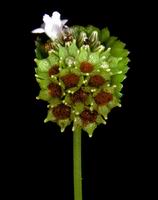
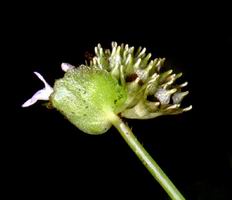
Penins. Malaysia, Pahang, Bkt. Charas, phot. A. Weber (1984)
Full name and orig. publication: Epithema Blume, Bijdr. Fl. Nederl. Ind. 737 (July-Dec. 1826).
Etymology: From the Greek έπιθεμα, epithema = lid, cover, crown, wreath, referring to the fruit, a pyxidium opening by a lid.
Synonyms: Carpocalymna Zipp. (1829), Aikinia R.Br. (1832) - non Wall. (1832).
Infrafamilial position: Epithematoid Gesneriaceae.
Description: Monocarpic herbs. Stem succulent, unbranched or branched. Cotyledons basal, the macrocotyledon developing to a long petiolate leaf that falls off early. Lower cauline leaf solitary, with long petiole and broadly ovate-cordate lamina, upper ones opposite, in one (rarely two) pair(s), subsessile, lamina ovate. Inflorescence pseudo-terminal, a very densely contracted pair-flowered cyme, usually embraced by a large cucullate bract. Flowers with short pedicel. Sepals connate in lower half, lobes triangular, spreading after anthesis and the calyx forming a campanulate cup. Corolla white or bluish, tube cylindrical, longer than limb, limb bilabiate. Nectary cup-shaped. Fertile stamens 2, the posterior pair, included, adnate above middle of corolla tube; filaments linear; anthers apically coherent, thecae divaricate, confluent at apex, longitudinally dehiscent; staminodes 2, the anterior pair, filaments longer than those of fertile stamens, distal parts upcurved. Ovary globose or ovoid, unilocular, placentae parietal; stigma subcapitate. Capsule globose, membranous, dehiscence circumscissile. Seeds oblong, ellipsoidal to spindle-shaped, spirally striate, with long, fleshy funicles.
Chromosome number: 2n = 16, 18, 24.
Species number: Over 20.
Species names (incl. publication and synonyms): See Skog, L.E. & J.K. Boggan. 2005: World checklist of Gesneriaceae: http://persoon.si.edu/Gesneriaceae/Checklist.
Type species: Epithema saxatila Blume
Distribution: S & SE Asia (NE India, Nepal, Bhutan, China, Myanmar, Thailand, Taiwan, Philippines, Java, Timor, Moluccas, New Guinea)., one species (E. tenue C.B.Clarke) in W Africa.
Ecology: On humid or wet limestone (less commonly on granite or quartzitic) rocks, in forest, at cave entrances etc.
Notes: The genus occupies a rather isolated position within the Epithematoid Gesneriaceae (Weber 1976, Mayer et al. 2003). It is unusual in the architecture of the plant body, the inflorescences and in the floral and fruit characters (HallÚ & Delmotte 1973, Weber 1976, 1988). Also remarkable is the disjunct distribution, with a gap from W Africa to India.
Selected references: HallÚ & Delmotte, Adansonia 13: 273-287 (1973), morph. & ecol.; Weber, Pl. Syst. Evol. 126: 287-322 (1976), morph.; Weber, Beitr. Biol. Pflanzen 63: 431-451 (1988), morph.; Hilliard & Burtt, Edinburgh J. Bot. 54: 111-113 (1997), new spp; Wang et al. in Wu & Raven (eds.), Fl. China 18: 400 (1998) reg. rev.; Hilliard, in Grierson & Long, Fl. Bhutan 2(3): 1328-1330 (2001), reg. rev.; Burtt, Thai Forest Bull. (Botany) 29: 81-109 (2001), annot. checklist (Thailand); Mayer, M÷ller, Perret, Weber, Amer. J. Bot. 90(2): 321-329 (2003), molec. syst.
Bibliography: See Skog, L.E. & J.K. Boggan. 2005. Bibliography of the Gesneriaceae. 2nd edition: http://persoon.si.edu/Gesneriaceae/Bibliography.
Illustrations:
 |
 |
Epithema saxatile Blume, type species
Penins. Malaysia, Pahang, Bkt. Charas, phot. A. Weber (1984) |
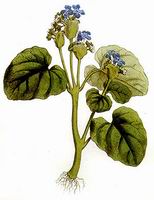
|
Epithema brunonis Wall.
Wall., Pl. Asiat. rar., t. 288 (1832) |
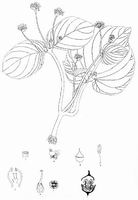 |
Epithema carnosum C.B.Clarke C.B.Clarke, Comm. & Cyrtandr. Beng., t. 90 (1874) |
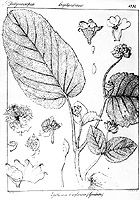 |
Epithema ceylanica Wight
Wight, Icon. pl. Ind. or., t. 1354 (1848) |
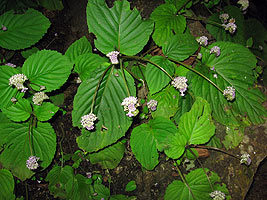
|
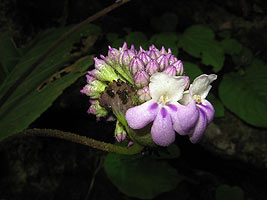
|
Epithema madulidii B.L.Burtt
Philippines, Palawan, El Nido, phot. U.Ferreras (2008) |
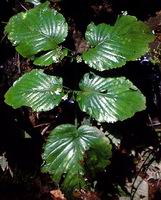 |
Epithema parvibracteatum B.L.Burtt
Penins. Malaysia, Selangor, Batu Caves, phot. A. Weber (1984) |
last modified: 2008-12-05